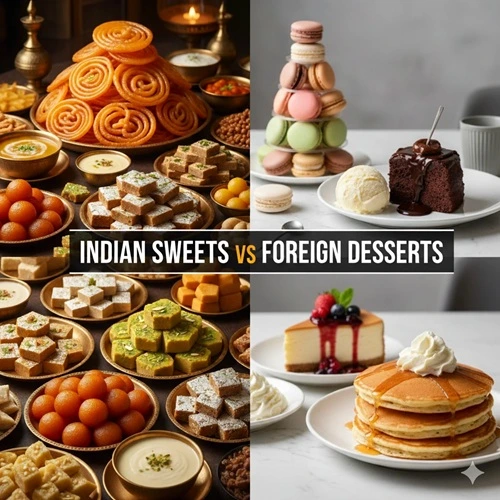There’s something deeply comforting about a bite of sweetness after a long day. Whether it’s a spoonful of warm gulab jamun soaked in syrup or a forkful of soft cheesecake melting in your mouth — desserts have an emotional pull that’s hard to resist.
Indian Sweets vs Foreign Desserts
But if you’re on a health streak, this is where the real dilemma begins. Should you reach for that traditional Indian sweet that reminds you of home and festivals or should you opt for the fancy foreign dessert that promises “less sugar” and a “healthier twist”?
Let’s be honest — sweets are not just food, they are memories, emotions and celebrations rolled into one. Especially in India, where every occasion — big or small — comes with a mithai ka dabba. So, can you stay healthy and still enjoy your favorite Indian sweets? Or are modern desserts the better choice? Let’s explore this delicious debate in detail.

The Emotional Connection with Indian Sweets
For every Indian, sweets are woven into the fabric of life. From laddoos offered during festivals to kheer made by mothers during special occasions — sweets symbolize love, sharing and happiness.
Think about it — Diwali without gulab jamun, Raksha Bandhan without barfi or a wedding without rasmalai just feels incomplete. These traditional recipes have been passed down for generations, often made with ingredients like milk, ghee, jaggery, dry fruits and love.
However, modern lifestyles, sedentary habits and increasing health consciousness have made people more cautious. The question now is — can these sweets fit into a balanced, healthy diet?
Understanding What Makes Indian Sweets Unique
Indian sweets or mithai are typically made using natural and dairy-based ingredients. The core elements include:
- Ghee: Provides richness, energy, and flavor.
- Milk and Khoya: Protein-rich and calcium-loaded.
- Jaggery or Sugar: Natural sweetness and quick energy.
- Dry Fruits: Packed with healthy fats and nutrients.
- Gram Flour, Semolina, or Rice Flour: Adds texture and protein.
The problem lies not in the ingredients themselves, but in quantity and preparation methods. Deep frying, excess sugar syrup and refined flour often turn otherwise wholesome sweets into calorie bombs.
What About Foreign Desserts? Are They Healthier?
Foreign desserts — think cheesecake, mousse, tiramisu, pastries or doughnuts — are equally indulgent but differ in composition. They often use ingredients like refined flour, heavy cream, butter and sugar.
However, in recent years, western desserts have evolved with the rise of “healthy alternatives.” You’ll find gluten-free brownies, sugar-free puddings, oat-based cookies and low-fat frozen yogurts dominating menus.
In contrast, Indian sweets haven’t fully embraced this health revolution yet. Most traditional sweets are still made with ample sugar and ghee, although healthier versions are slowly gaining popularity.
Nutritional Comparison: Indian Sweets vs Foreign Desserts
Let’s break down a few examples to see how they compare nutritionally.
| Dessert | Average Calories (per serving) | Sugar Content | Fat Content |
|---|---|---|---|
| Gulab Jamun (2 pcs) | 300–350 kcal | High | Moderate |
| Rasgulla (2 pcs) | 200–250 kcal | High | Low |
| Besan Ladoo (1 pc) | 150–180 kcal | Moderate | High (healthy fats) |
| Cheesecake (1 slice) | 350–400 kcal | High | High |
| Chocolate Mousse (1 cup) | 300–350 kcal | High | High |
| Tiramisu (1 serving) | 400+ kcal | High | High |
From a purely nutritional standpoint, neither wins by a large margin. However, Indian sweets made at home can be customized for better nutrition — something you can’t always do with store-bought desserts.
Indian Sweets vs Foreign Desserts: If You’re on a Health Streak – Here’s the Truth
Being on a health streak doesn’t mean you have to give up sweets entirely. It’s about balance, moderation and smart choices.
Here’s how you can enjoy your favorite Indian sweets without guilt:
1. Choose Homemade Over Store-Bought
When you make sweets at home, you control the ingredients. Use less sugar, replace white sugar with jaggery or stevia and reduce the amount of ghee slightly. Homemade kheer with jaggery and almonds is far healthier than packaged chocolate pudding.
2. Portion Control is Key
You don’t need to eat five gulab jamuns to satisfy your craving. Sometimes, one small piece is enough to calm your sweet tooth. Train your taste buds to enjoy smaller portions.
3. Opt for Healthier Ingredients
- Replace refined sugar with jaggery, honey or dates.
- Use low-fat milk or almond milk.
- Add nuts, seeds and fruits for natural sweetness and texture.
- Try baking instead of deep frying.
4. Time It Right
Having sweets after a meal helps slow down sugar absorption. Avoid eating them late at night or on an empty stomach.
5. Don’t Mix Too Many Sweets
Combining multiple desserts (like halwa + gulab jamun + ice cream) in one sitting can overload your system. Pick one and enjoy it mindfully.
To Get the regular updates on our new post, Follow us on Instagram
Are Indian Sweets Safe to Consume?
Yes — but in moderation and with mindfulness.
Traditional Indian sweets, when made from quality ingredients and without artificial additives, are far safer than many processed desserts found in supermarkets.
Here’s why:
- No artificial preservatives (if made fresh).
- Natural ingredients like milk, ghee and nuts.
- Cultural alignment with our digestive systems — our bodies are more used to these flavors and components.
The only catch is portion and frequency. Daily indulgence can spike sugar levels, but occasional treats — especially on festivals — are perfectly fine.
Healthy Indian Sweets You Can Enjoy Guilt-Free
If you want to stay on your health track while enjoying the taste of home, try these lighter and nutritious Indian sweets:
- Dates and Nuts Ladoo: No added sugar, naturally sweet and full of fiber.
- Jaggery Til Chikki: Great source of iron, calcium and healthy fats.
- Baked Rasgulla: Less syrupy but equally delicious.
- Oats and Coconut Barfi: High in fiber and easy to digest.
- Moong Dal Halwa with Less Ghee: Protein-rich and comforting.
- Ragi Ladoo: Made from finger millet — rich in calcium and iron.
- Low-fat Paneer Sandesh: A Bengali sweet that’s light and protein-rich.
If You Love Foreign Desserts, Choose Wisely
If you’re tempted by foreign desserts, here’s how to keep them on the healthier side:
- Choose Greek yogurt parfaits over creamy puddings.
- Go for dark chocolate desserts instead of milk chocolate.
- Pick fruit-based tarts instead of cream-filled pastries.
- Try baked cheesecakes instead of no-bake versions full of cream cheese and sugar.
- Replace whipped cream toppings with fresh fruits or nuts.
Indian Sweets vs Foreign Desserts: The Mindful Eating Approach
Instead of labeling sweets as “good” or “bad,” focus on how you eat them. Mindful eating is the real secret to enjoying desserts without harming your health.
- Savor the flavor: Eat slowly and consciously.
- Understand your craving: Are you eating out of hunger or habit?
- Pair with activity: A short walk after dessert helps digestion and prevents sugar spikes.
So, Which Is Better — Indian Sweets vs Foreign Desserts?
The answer lies not in the sweet, but in the serving size and mindset.
- If made at home with healthy ingredients, Indian sweets are often more natural and culturally suitable for your body.
- If you prefer the occasional foreign dessert, choose wisely and control your portion.
Ultimately, it’s not about choosing sides. It’s about balance — enjoying your favorite treats while staying committed to your health goals.
After all, life’s too short to say no to kheer on your birthday or a gulab jamun on Diwali. Just make sure you earn that sweetness with conscious eating and an active lifestyle.
Indian Sweets vs Foreign Desserts: Final Thoughts
Sweets — whether Indian or foreign — bring joy. They celebrate life’s best moments and remind us that food isn’t just fuel, it’s emotion. The real key to staying healthy while enjoying them lies in moderation, mindfulness and awareness.
So, go ahead — have that bite of mithai or slice of cake. Just don’t let the sweetness overpower your self-control. Remember, the best dessert is the one that satisfies your soul, not just your taste buds.
For more such Health & Lifestyle Information or Food Updates, Please Follow Popnewsblend.com

Hi, I’m Prashant Jain — a curious soul, storyteller, and content creator at heart.I’ve always been drawn to the world of entertainment, travel, sports, health & lifestyle — not just as a writer, but as someone who genuinely lives these experiences. Whether I’m binge-watching the latest OTT series, exploring offbeat spiritual destinations in India, or diving deep into wellness routines and cricket match insights, I love sharing what I discover with like-minded readers.
PopNewsBlend is my way of blending personal journeys with meaningful stories — ones that inform, inspire, and keep you ahead of the curve. Everything I write comes from real observations, hands-on experiences, and a deep passion for understanding the world around us.
Discover more from Popnewsblend
Subscribe to get the latest posts sent to your email.







